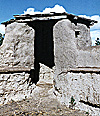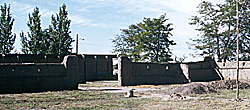 Fort Vasquez sits in the middle of highway 85, about halfway between Denver and Greeley, Colorado, smack next to a truck weigh station. Besides the rush of cars on both sides of the fort, there is the omnipresent squeal of truck brakes, explosive hisses of air pressure release, and the gutteral roar of diesel engines.
Fort Vasquez sits in the middle of highway 85, about halfway between Denver and Greeley, Colorado, smack next to a truck weigh station. Besides the rush of cars on both sides of the fort, there is the omnipresent squeal of truck brakes, explosive hisses of air pressure release, and the gutteral roar of diesel engines.
A small museum fills in the space between station and fort. It is open only a couple days a week, and sadly, the day I arrived was not one of them. Pressing my nose against the window glass and shielding my eyes from the glare, I spied a variety of artifacts in the museum, mostly of the trading goods variety since Fort Vasquez was started as a trading post.
When it was started is a bit of a mystery. One sign, erected in 1933, states it was established in 1837. Another sign, with a short history, contends it was built in 1835.
The Sign
This latter sign explains the origins of the fort:
 In the area along the South Platte River, competing fur companies in the late 1830s established a string of four adobe trading posts -- Fort Vasquez, Fort St. Vrain, Fort Jackson, and Fort Lupton. Traversed by the old trapper's trail, which connected Fort Bent on the Arkansas River with Fort Laramie on the North Platte, this country of wide horizons was the commercial center of a vast region. Here, trappers, traders and Indians bartered calico, knives, and beads for buffalo robes and beaver skins.
In the area along the South Platte River, competing fur companies in the late 1830s established a string of four adobe trading posts -- Fort Vasquez, Fort St. Vrain, Fort Jackson, and Fort Lupton. Traversed by the old trapper's trail, which connected Fort Bent on the Arkansas River with Fort Laramie on the North Platte, this country of wide horizons was the commercial center of a vast region. Here, trappers, traders and Indians bartered calico, knives, and beads for buffalo robes and beaver skins.
Built in 1835 by Louis Vasquez (later partner of Jim Bridger) and Andrew Sublette, the fort was once flanked by the South Platte River. In the spring of 1840, a Macinaw boat was launched here loaded with 700 buffalo robes and 400 buffalo tongues. It reached St. Louis in 69 days.
 Abandoned in 1842, the fort was ransacked by Indians. Later, partially restored, it sheltered gold rush emigrants and troops during the Indian troubles.
Abandoned in 1842, the fort was ransacked by Indians. Later, partially restored, it sheltered gold rush emigrants and troops during the Indian troubles.
Fort Vasquez was reconstructed on its original site from adobe bricks made from remains of its crumbling walls.
Weld County's so-called First Court House stands near the gate.
Fort Dimensions
 The fort is square, with approximately 90 feet of wall on a side. Each wall has about 12 firing slits. The walls today are about 6.5 feet high and a little more than 1 foot thick. A sill a little less than one foot wide allows for a defender to rest an elbow while firing out a slit.
The fort is square, with approximately 90 feet of wall on a side. Each wall has about 12 firing slits. The walls today are about 6.5 feet high and a little more than 1 foot thick. A sill a little less than one foot wide allows for a defender to rest an elbow while firing out a slit.
 The north face has two corner towers, but the south face has none. The towers are about 10 feet high and measure 6 feet by 6 feet on the inside. They jut 3 feet out from the walls.
The north face has two corner towers, but the south face has none. The towers are about 10 feet high and measure 6 feet by 6 feet on the inside. They jut 3 feet out from the walls.
 The main gate, approximately 12 feet wide, is in the middle of the south face, leaving about 34 feet of wall on each side.
The main gate, approximately 12 feet wide, is in the middle of the south face, leaving about 34 feet of wall on each side.
Large Photos (4) of Fort walls and tower (extremely slow: 563K)
Back to List of Historic Sites
Back to Travel Master List
Back to MagWeb Master List of Magazines
© Copyright 1998 by Coalition Web, Inc.
This article appears in MagWeb (Magazine Web) on the Internet World Wide Web.
Other military history articles and gaming articles are available at http://www.magweb.com